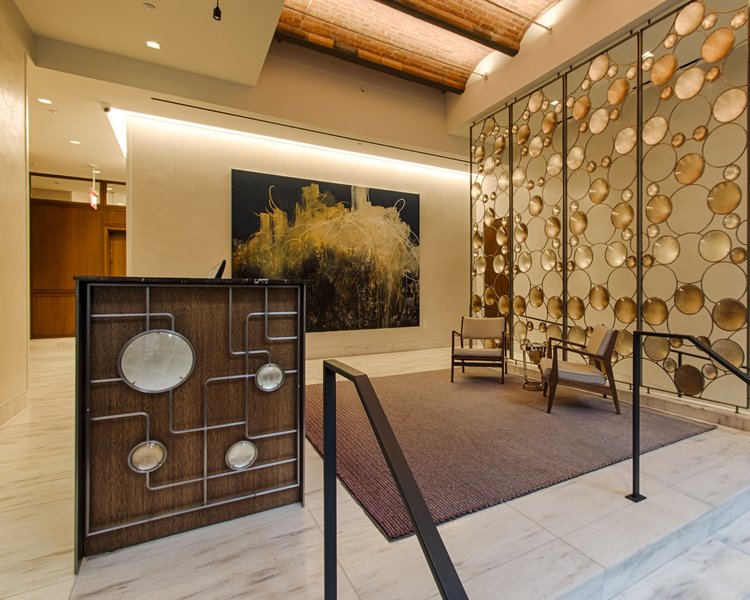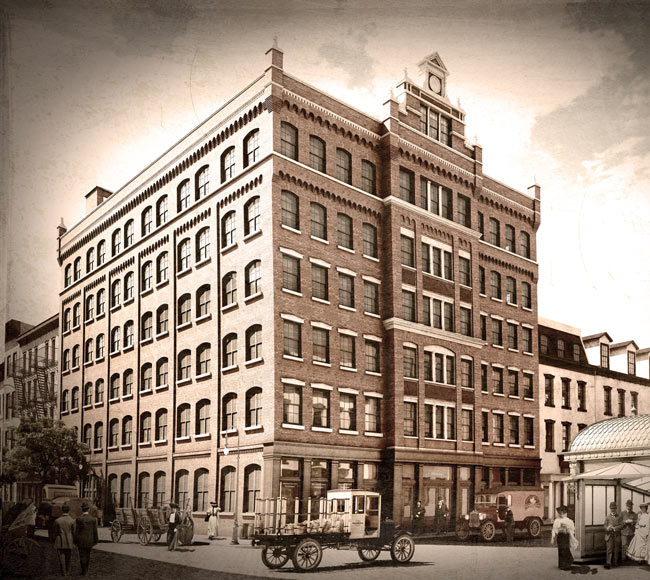.jpg?width=750&height=500&name=36%20Bleecker%20Street%20-%20NYC,%20NY%20-%20White%20Georgia%20(10).jpg)
The Schumacher and Bleecker Street have history. Located in the beautiful, iconic and oh-so chic neighborhood of New York City’s NoHo, this restored building has been sitting pretty on 36 Bleecker Street between Mullberry and Mott since the late 1800s when it was first constructed. Its roots are in the Romanesque Revival Style and once upon a time, featured grand design details such as corbelled brick layering, ornamental overhangs, radiating lintels, arched windows and parapets and turrets.
As it was originally designed to house the Schumacher and Ettlinger lithographic printing business, this historic building, now part of an adaptive reuse, pays homage to its long-standing heritage by keeping the eponymous name it has always been known for. To ensure its timeless aesthetic, development company and building owner, Stillman Development, passed the reins over to Morris Adjmi Architects to revive and bring life back to the Schumacher as a community of upscale loft residences.
What hasn’t changed in The Schumacher is the prominent use of American marble, starting with the ground floor lobby and flowing out to its courtyard where a modern installation of marble blends the old and the new.

The Schumacher lobby. Photo credit: Focus Lighting
“There were a lot of challenges”, laughed Wes Wolfe of Morris Adjmi Architects, who was the lead architect on the project, “as you can imagine, with a historic building like this, converting it to a high-end residential building was not easy.”
Interestingly enough, those challenges revealed that the use of white marble was and still is a common thread between the old and new Schumacher building. “The building was curious in that it had these stone subfloors. When we did a demolition we uncovered that all the subfloors of the original building were white marble, maybe for durability since they had heavy machinery on them.”
In an effort to maintain the Schumacher’s character Wolfe and his team did their best to modernize the building without losing its historical significance.

During the restoration the team discovered an old 1904 photograph which showed that the building originally had a pediment that had later been destroyed. The oblique angle of the building made it difficult for Morris Adjmi Architects to see the precise details. Looking at the work of the original architect Edward E. Raht, they found a drawing for Union Club design competition that also incorporated a similarly styled pediment. This research became the basis for The Schumacher’s new pediment design.
“Obviously it’s a quirky, historic building and we retained a lot of the ceiling structures and the brick vaults and all that. We were also able to add this pediment in the center of the building that had fallen off in the 1920s. We found documentation of what it was and put it back. It was an interesting way to incorporate it for landmark approval and to add the penthouse element.”

The Schumacher, now restored. Photo by NY Curbed
Given that the white marble was a connective thread, No. 36 Bleecker Street had no better match in quality and heritage than the historic GEORGIA MARBLE-WHITE GEORGIA™ Like small batch reserve spirits, this American marble is reserved for historic adaptive reuse and heritage projects such as the major 2013 addition to The Clevelend Museum of Art. White Georgia is mainly used for large architectural projects. You can find this marble in most of the historical landmarks both in and around the nation’s capital. Visit the Lincoln Memorial and you’ll see its beautiful composition and eye-catching silver-colored veins up close.
“It was a project which needed a lot of attention regarding the color quality and veining,” said Sylvie Beaudoin, project manager at Polycor’s Tate, Georgia marble quarry. “We had to use the cleanest, whitest White Georgia we had on hand.”
.jpg?width=750&height=500&name=36%20Bleecker%20Street%20-%20NYC,%20NY%20-%20White%20Georgia%20(8).jpg)
"The architect placed a lot of emphasis on the vein orientation in the White Georgia marble,” Beaudoin said. "Since most of the field tiles were the same size we had to take into account the veining direction so the final effect would look more uniform. Because we cut blocks directly from our own quarries we are able to have this level of control on projects. For example on the vertical base pieces around the lobby we made sure to take the veining into account so it would flow through the room and up the wall seamlessly, instead of just running the veins parallel to the longest direction of the tile."
.jpg?width=750&height=948&name=36%20Bleecker%20Street%20-%20NYC,%20NY%20-%20White%20Georgia%20(6).jpg)
For Wolfe the material selection was extra appropriate given the project’s part in New York City history. “It’s nice to use a domestic stone sometimes because we are often using Italian stones,” he said.
Long time leaders in the stone setting craft, Miller Druck Specialty Contracting handled the stone installation. “Barbara (of Miller Druck) is very knowledgeable and has a very high level of quality standard on her projects,” Beaudoin said. “This was especially important for the vein layout specified.”
.jpg?width=750&height=500&name=36%20Bleecker%20Street%20-%20NYC,%20NY%20-%20White%20Georgia%20(9).jpg)
From restored architectural pieces to the white marble subfloors and even the exterior to the interior, the Schumacher is in a sense a compilation of many different elements all woven together. Throughout the entire project the White Georgia marble is not only a defining feature but a connective one as well — providing inspiration and sparking new design ideas.
“The building has a courtyard in the center of it [...] and Ken Smith, the landscape architect, came up with this very interesting concept of vines running along cables at different angles with beams on top that would hold the cables,” Wolfe said. “He also came up with the idea of a field of white boulders — roughly hewn, shaped rocks — which would create a sort of floorscape in the courtyard."
“We decided to pick up on [Smith’s design] to have some continuity in the lobby of the building and to use the same material in a nice honed finish because we liked the quality of it and the light grey veining,” he said.
From the moment you step into the building and begin to look around, the elegant aesthetic of the Georgia marble greets you and provides a sense of time and place. Thanks to its homogenous quality, the stone is easily incorporated into the updated space without ever feeling like an afterthought.
“It runs from the main lobby to the library that’s a shared, public amenity space facing the courtyard,” Wolfe said, “We have a hand-applied Venetian stucco treatment on the lobby walls that’s above the marble baseboards, so we turned the Georgia marble up the walls to provide a durable base there. Our use of it was fairly straightforward, we kept it in a base of larger format squares and didn’t do anything that tricky.”
Heritage materials like American marble make an authentic connection between past and present in adaptive reuse projects. Polycor, which owns its own marble quarry in Georgia, also has capabilities for the cut-to-size blocks and custom large format tiles often needed for restorations or retrofits like The Schumacher.
Learn more about this American marble, download the White Georgia spec sheet.
